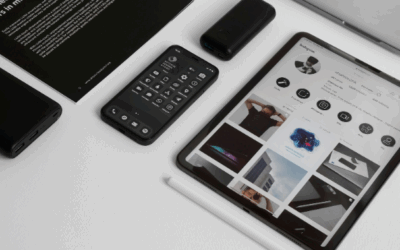You pour hours into ad copy that barely nudges your conversion rates. Most marketers miss simple shifts that make all the difference in landing page optimization. This post breaks down how to write high-converting copy, covering audience understanding, crafting...
Mastering B2B Email Marketing: Strategies to Boost Your Lead Generation Efforts

Categories
You may also like…
Essential Best Practices for Mobile Website Performance
Most websites lose over half their visitors because pages don't load quickly or navigation feels clunky on phones. If your site isn't built with mobile optimization in mind, you're missing out on traffic and better rankings. This post breaks down simple steps like...
Harness the Power of Social Media Advertising for Black Friday Promotions
Black Friday marketing can make or break your holiday sales. Many small businesses miss key chances because their email campaigns and website aren't ready for the rush. This post breaks down simple marketing tips, like timing urgency-driven offers and boosting social...
Email marketing stands as a cornerstone for B2B lead generation, offering an unparalleled opportunity to connect directly with potential clients. By harnessing the power of targeted email campaigns, you can effectively nurture leads, share valuable content, and turn prospects into loyal customers. This piece will delve into essential strategies to elevate your B2B email marketing efforts, including crafting eye-catching subject lines, segmenting your audience for maximum impact, and personalizing messages to boost email engagement. Get ready to enhance your lead generation strategies and see your email campaigns thrive!
Crafting Compelling Subject Lines
Capturing Attention Quickly
Capturing attention quickly is crucial in B2B email marketing. With countless emails flooding inboxes daily, your subject line needs to stand out. Start by keeping it concise—aim for under 50 characters. This ensures it’s visible on mobile devices. Use action-oriented language to spark curiosity and encourage opens. Highlighting the value proposition in the subject line can make a difference. For example, “Boost Your Sales with These 3 Tips” promises immediate benefits. Incorporating personalization in email subjects, like using the recipient’s name or company, can also increase engagement. Avoid using ALL CAPS or excessive punctuation, which might trigger spam filters. Instead, test different variations to see what resonates with your audience. Remember, the subject line is your first chance to engage, so make it count.

Encouraging Email Opens
Encouraging email opens is a key goal when crafting subject lines. To achieve this, focus on relevance. Tailor your message to address current needs or pain points. Using numbers or lists in the subject can boost open rates—consider phrases like “5 Ways to Improve ROI”. A/B testing different subject lines allows you to identify what works best for your audience. Timing also plays a crucial role; send emails when your audience is most active. Experiment with questions in your subject lines to provoke thought and engagement, such as “Is Your Marketing Strategy Up to Date?” Avoid misleading or clickbait tactics, as they can harm trust. Instead, ensure that the subject line accurately reflects the email’s content. Building a reputation for delivering valuable content will naturally encourage more opens over time.
Balancing Curiosity and Clarity
Balancing curiosity and clarity in subject lines is often the secret to driving email engagement. You want to pique curiosity, yet provide enough information so recipients know what to expect. A good approach is to use intriguing teasers without being vague. For instance, “Unlock the Secret to Higher Conversions” invites curiosity but hints at the email’s focus. Clarity ensures the relevance of the message, preventing disappointment and boosting trust. It’s also wise to align the tone of the subject line with your brand voice and the content within. Overpromising or using overly sensational language can lead to high open rates but low engagement, as recipients may feel misled. As you refine your B2B email marketing strategy, consider the balance of curiosity and clarity in your subject lines to maintain a strong connection with your audience.
Audience Segmentation Techniques
Importance of Targeting
Targeting is fundamental in B2B email marketing because it ensures the right message reaches the right audience. By segmenting your email list, you can tailor your content to meet specific needs and challenges of different groups. This personalized approach leads to higher engagement, as recipients find the content more relevant and valuable. Segmentation can be based on various criteria, such as industry, company size, or past interactions. For example, targeting small businesses with cost-effective solutions, while offering scalability options to larger enterprises, demonstrates understanding and relevance. Proper targeting also enhances the efficiency of your campaigns, reducing unsubscribes and increasing conversion rates. Moreover, it helps in nurturing leads effectively by sending content that aligns with their position in the buyer’s journey. In summary, targeting is not just about reaching more people—it’s about reaching the right people with messages that matter.
Methods for Effective Segmentation
Effective segmentation in B2B email marketing can significantly enhance your lead generation strategies. Start by segmenting your audience based on firmographics, such as industry, company size, or location. This allows you to tailor messages that resonate with specific business needs. Behavioral segmentation is also valuable; analyze past interactions, like email opens and clicks, to identify engaged segments. Use this data to craft personalized follow-ups. Additionally, consider the buyer’s journey stage—send introductory content to new leads while offering detailed insights to prospects closer to conversion. Technology can aid in segmentation; employing CRM systems or email marketing platforms with segmentation features allows for dynamic lists that update based on real-time data. Regularly review and refine your segments, as businesses evolve and new trends emerge. By employing these methods, your targeted email marketing efforts will be more aligned with audience expectations, boosting overall email engagement and conversion rates.
Analyzing Segment Performance
Analyzing segment performance is crucial for refining your B2B email marketing strategy. Begin by evaluating key metrics like open rates, click-through rates, and conversion rates for each segment. These indicators provide insights into which segments are responding well and which require adjustment. A/B testing within segments can help pinpoint effective strategies, allowing you to optimize content and timing. Use reporting tools in your email marketing platform to track these metrics over time, identifying trends and shifts in behavior. Pay attention to feedback and engagement patterns—low performance might indicate a need for better targeting or content relevance. Also, consider external factors like market changes that might impact segment behavior. Regular analysis enables you to adapt your lead generation strategies, maximizing efficiency and impact. By consistently monitoring and adjusting your segments, you ensure that your targeted email marketing efforts remain aligned with evolving audience needs.
Personalization in Email Campaigns

Building Personalized Connections
Building personalized connections through email campaigns is essential for enhancing engagement and fostering loyalty. Start by addressing recipients by name, and tailor content to their specific interests or challenges. Use data from previous interactions to customize offers or recommendations, making sure each email feels relevant and valuable. Dynamic content, such as personalized product suggestions or tailored resources, can significantly boost engagement rates. Incorporate personalized send times based on when a recipient is most likely to open emails, increasing the chances of interaction. Beyond basic personalization, consider adding elements like personalized videos or messages from a dedicated account manager to deepen the connection. Continuously gather feedback and update personalization strategies to better align with recipient needs. By focusing on building these personalized connections, you not only enhance email engagement but also strengthen relationships, turning leads into long-term, loyal customers.
Tools for Dynamic Content
Utilizing tools for dynamic content in your email campaigns can greatly enhance personalization and engagement. Dynamic content allows you to create emails that adapt based on each recipient’s preferences and behavior. Email marketing platforms like Mailchimp, HubSpot, and Salesforce offer dynamic content features that enable you to insert personalized elements such as product recommendations, tailored offers, or location-based content within your emails. These tools often integrate with CRM systems, providing real-time data to refine content delivery. Additionally, leveraging AI-driven platforms can automate personalization, ensuring emails are timely and relevant. By using these tools, you can segment your audience more effectively and deliver messages that resonate on an individual level. Regularly update and test your dynamic content to align with changing customer preferences and behaviors. This approach not only boosts email engagement but also strengthens overall lead generation strategies by making each interaction more meaningful and relevant.
Leveraging Customer Data
Leveraging customer data is key to effective personalization in email campaigns. Start by collecting comprehensive data from various touchpoints—website interactions, purchase history, and social media activity. This data helps create detailed customer profiles, enabling you to tailor content precisely to their needs and preferences. Implementing a robust CRM system can streamline data collection and analysis, providing valuable insights into customer behavior. Use this information to segment your audience, ensuring each group receives content that resonates. Behavioral data, such as past purchases or browsing patterns, can guide personalized product recommendations or special offers. Additionally, feedback and surveys can provide qualitative data, offering deeper insights into customer expectations. Regularly update your data sets to reflect changes in customer behavior and preferences. By effectively leveraging customer data, your email campaigns will become more targeted, relevant, and engaging, ultimately enhancing email engagement and driving stronger lead generation outcomes.
Boosting Email Engagement

Creating Valuable Content
Creating valuable content is a cornerstone of boosting email engagement. Start by understanding your audience’s needs and challenges, then craft content that addresses these directly. Offer solutions, insights, or tips that they can apply immediately, ensuring that your emails provide tangible benefits. High-quality content can include industry news, detailed guides, or case studies showcasing successful outcomes. Visual elements like infographics or videos can enrich the experience, making complex information more digestible. Ensure your content is well-organized, with clear headings and concise paragraphs, to facilitate easy reading. Additionally, use a consistent tone that aligns with your brand’s voice, helping to build a recognizable and trustworthy presence. Regularly solicit feedback to refine your content strategy and stay aligned with audience expectations. By consistently delivering valuable content, you not only boost email engagement but also strengthen relationships, positioning your communications as a go-to resource for your audience.
Timing and Frequency Tips
Timing and frequency are critical factors in boosting email engagement. Sending emails when your audience is most likely to check their inbox can significantly increase open rates. Analyze past campaign data to identify peak engagement times, and consider using automated scheduling tools to optimize delivery. As for frequency, striking the right balance is essential. Too many emails can lead to unsubscribes, while too few can cause your audience to lose interest. Segment your audience to tailor frequency based on their engagement levels—more engaged segments might appreciate more frequent updates, while others may prefer less. It’s also beneficial to allow subscribers to set their preferences for how often they receive emails. Testing different timing and frequency strategies can provide insights into what works best for your audience. By aligning your email send schedule with recipient habits and preferences, you enhance the chances of your messages being read and acted upon, ultimately improving email engagement.
Measuring Engagement Success
Measuring engagement success in B2B email campaigns involves tracking various key performance indicators (KPIs). Begin with basic metrics like open rates and click-through rates, which provide initial insights into how well your subject lines and content resonate with your audience. Dive deeper by analyzing conversion rates to assess how effectively emails drive desired actions, such as downloads or purchases. Bounce rates can highlight issues with email deliverability or list quality. Utilize tools like Google Analytics to track website traffic originating from your emails, giving a broader view of engagement. It’s also important to monitor unsubscribe rates, as sudden spikes may indicate content misalignment. Regularly evaluate these metrics to identify trends and areas for improvement. Setting benchmarks and goals for each campaign will help measure progress over time. By consistently analyzing engagement metrics, you can refine your strategies, ensuring your email campaigns remain effective and aligned with audience expectations, ultimately boosting lead generation success.
Converting Leads Into Customers
Nurturing Leads with Email
Nurturing leads with email is a vital step in converting them into customers. The process involves sending a series of well-timed and relevant emails that guide prospects through the buyer’s journey. Start by segmenting your leads based on their interests and stage in the sales funnel. Create a content plan that addresses their specific needs, providing valuable information at each touchpoint. Use a mix of educational content, such as blogs or whitepapers, and promotional offers to maintain interest. Personalization in email plays a crucial role here—tailor each message to reflect the recipient’s preferences and past interactions. Automation tools can streamline the nurturing process, ensuring timely follow-ups and consistent communication. Monitor engagement levels to adjust your strategy accordingly, focusing more on active leads. By effectively nurturing leads with email, you build trust and demonstrate value, setting the stage for a successful conversion into loyal customers.
Transitioning from Lead to Customer
Transitioning from lead to customer involves strategically guiding prospects through the final stages of their decision-making process. Begin by identifying leads that show high engagement and readiness to purchase—these could be indicated by frequent interactions with your content or direct inquiries. At this stage, focus on addressing any remaining objections or questions they might have. Provide detailed case studies, testimonials, or personalized demonstrations to reinforce the value of your product or service. Offering tailored incentives, such as special discounts or limited-time offers, can also help nudge leads towards conversion. Ensure that your sales and customer service teams are aligned and ready to support these prospects with any additional information or assurances they need. By maintaining clear and open communication, you can ease the transition from lead to customer, ensuring the process is smooth and satisfactory. This approach not only increases conversion rates but also lays the foundation for a strong, ongoing customer relationship.
Retention Strategies Post-Conversion
Retention strategies post-conversion are crucial for maintaining customer loyalty and maximizing lifetime value. Once a lead converts into a customer, the focus should shift to delivering exceptional experiences and ongoing engagement. Start by ensuring a smooth onboarding process, and providing clear instructions and support to help customers make the most of your product or service. Regularly check in with personalized emails that offer value, such as tips, updates, or exclusive content. Implement a feedback loop through surveys or reviews to understand customer satisfaction and areas for improvement. Utilize loyalty programs or referral incentives to reward repeat business and word-of-mouth promotion. Personalized offers based on purchase history can further enhance customer satisfaction. Keep communication channels open, ensuring that customers can easily reach your support team for assistance. By prioritizing these retention strategies, you not only foster a strong relationship with your customers but also encourage long-term engagement and advocacy.



